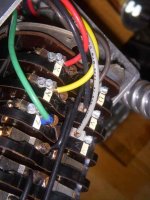MyrtleLake
Stainless
- Joined
- Nov 23, 2008
- Location
- Chicago, IL
Okay, my de-facto electrician that usually does all my wiring is MIA. I recently had my lathe motor burn itself up. Before disconnecting it, I recorded all the leads from the 2-speed reversing switch to the terminal block on the motor. I then had the motor repaired (full rewind  )
)
When I received the motor back, the motor shop had removed the terminal block, citing that they often cause problems (no issue with that from me). BUT, they did not record the order of the motor lead connections to the original terminal. I am left with 6 numbered leads that exit the motor.
I tried inquiring with the motor shop, but I didn't understand a word of it. There is a reason I usually leave electrical work to the electricians!
Here is what I DO know:
*From the 2-speed reversing switch the red, green, yellow is one speed. The black, black, grey is the second speed. There is also a second green which I know is the ground.
*From the motor, numbers 1,2,3 are speed one. Numbers 4,5,6 are speed two.
*The motor is, specifically: 220V, 60hz, 3~, 900/1800rpm, .5hp/.7hp
Here is what I DON'T know:
*3~ power is run from a RPC. Would you expect the Red and the Grey lines to be the third leg?
*Does it matter what order the three wires from the motor for a given speed and the three wires from the switch are connected? Other than rotational direction?
*A little of a reiteration, but will I damage the motor if the RPC lead is connected to anything other than T3 (speed one) or T6 (speed two)
*I am fairly certain the colored leads from the 2-speed switch are for the slower speed and the Black/grey for faster speed. Still, unsure. But if it was reversed, it would cause no damage, right? To my understanding, it is still the same line current, just activating a separate winding in the motor.
OR
If I get a multimeter, would I be able to answer the questions above with better accuracy? Full disclosure: I have no idea how to use a multimeter.
Help
 )
)When I received the motor back, the motor shop had removed the terminal block, citing that they often cause problems (no issue with that from me). BUT, they did not record the order of the motor lead connections to the original terminal. I am left with 6 numbered leads that exit the motor.
I tried inquiring with the motor shop, but I didn't understand a word of it. There is a reason I usually leave electrical work to the electricians!

Here is what I DO know:
*From the 2-speed reversing switch the red, green, yellow is one speed. The black, black, grey is the second speed. There is also a second green which I know is the ground.
*From the motor, numbers 1,2,3 are speed one. Numbers 4,5,6 are speed two.
*The motor is, specifically: 220V, 60hz, 3~, 900/1800rpm, .5hp/.7hp
Here is what I DON'T know:
*3~ power is run from a RPC. Would you expect the Red and the Grey lines to be the third leg?
*Does it matter what order the three wires from the motor for a given speed and the three wires from the switch are connected? Other than rotational direction?
*A little of a reiteration, but will I damage the motor if the RPC lead is connected to anything other than T3 (speed one) or T6 (speed two)
*I am fairly certain the colored leads from the 2-speed switch are for the slower speed and the Black/grey for faster speed. Still, unsure. But if it was reversed, it would cause no damage, right? To my understanding, it is still the same line current, just activating a separate winding in the motor.
OR
If I get a multimeter, would I be able to answer the questions above with better accuracy? Full disclosure: I have no idea how to use a multimeter.
Help

Attachments
Last edited:





